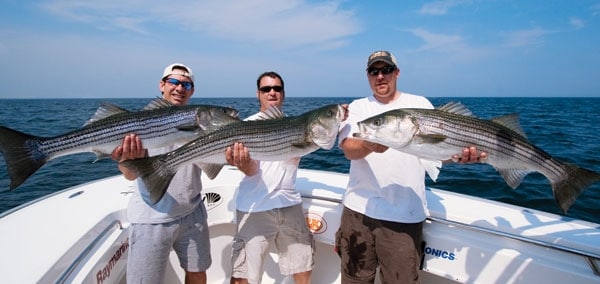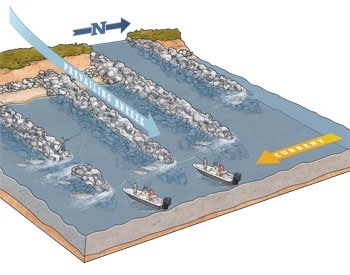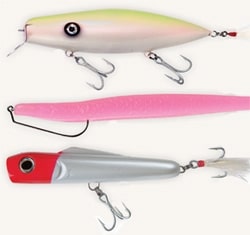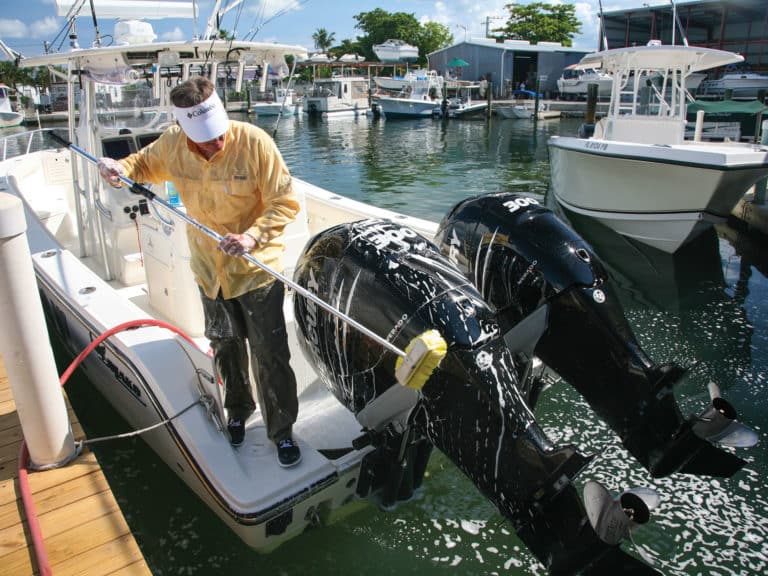
The Jersey Shore rocks during the summer season, but beyond the fist-pumping beat of the boardwalk, the rickety roller coasters and the special blends of boardwalk ice cream lies the kind of rock that is home to New Jersey’s premier game fish.Welcome to Jetty Country.
From Sandy Hook to Cape May, rock structures along the shoreline, referred to as groins or jetties, jut into the ocean. In some areas the jetties are staggered every quarter-mile, and in other places they are more widely spaced. If you can find the right section, you’ll find striper heaven.
These jetties were originally placed by the Army Corps of Engineers as shore-protection structures. Aligned perpendicular to the shoreline, they were designed to reduce the transport of sand along coastlines. The same current that carries sand along the coast combines with the underwater structures to create holding and feeding areas for bass from spring through summer and fall, when thousands of [striped bass](/Joe Mahler) migrate up the coast and take up residence on these jetties. At any given time, there can be anywhere from five to 25 bass residing on every jetty tip, making the jetties consistent spots to catch stripers along the Jersey Shore.
Recent studies have indicated that increasing the jetties’ per-meability with breaks or breaches provides better shoreline stabilization. These notches deny shorebound anglers access to the sweet spots, the jetty tips. For boat anglers, however, jetty tips are rich fishing grounds.
Jetty Basics
As with any saltwater fishing, timing determines the best action. Tides, sunlight, wind direction and water temperature all play important roles in when to fish these rock piles. Also, be attentive to wind, current and surf conditions. The wrong combination can put you on the rocks in short order, so plan your approach and drift to avoid dangerous conditions. Jetty rocks are unforgiving. Pay close attention to stay safe.
Though stripers will feed during any time of the day, I have found the best times for the most consistent action to be dawn and dusk. I have caught many fish in high sunlight, but anglers will usually get more follows than takes during the middle hours of the day. The exception to this rule is obviously cloudy or overcast days. As the sun drops, the bite will usually pick up again, with the hours just before dark usually producing good results. For expert anglers who know the jetties inside and out, nighttime can also be very productive, especially when fishing eels for larger fish.
Getting to a rock pile first can prove very effective. Because each jetty holds only a handful of fish, pulling up on a jetty tip right after another boat has fished it is usually a waste of time. Spend an hour or two finding other tips that have not been fished recently, then come back later, after the jetty has had a chance to rest. Knowing when to move to another tip is also important. Don’t take too much time on one jetty tip, as your best bites will usually come right away. As a general rule, I will put about five to 10 casts on each jetty, and if I do not score, I move on. If the action is good, I usually stay until the fish stop hitting and start following the lures or baits. Sometimes changing to a new bait or lure or putting on a different color can evoke a strike after the bite has gone quiet.
When a fish hits, do your best to try to pull it away from the rocks quickly. Allow the fish to have too much play or drag, and it will bury itself on the other side of a big rock and break you off. I keep my drags tight and try to get the fish at least 10 to 15 yards away from the rocks, into deeper water, as soon as I can. As the fish approaches the boat, look for others following it. This is when a second angler can throw another bait or lure and get hooked up.
Next time you’re at the Jersey Shore, forgo the walk down the crowded boardwalk one day and hit the rocks for some fist-pumping striper action. You won’t be disappointed.
Jersey Jetties

Jetty fishing means fishing around rocks, so long, heavy fluorocarbon leaders from 10 to 15 feet, which provide leeway when fish wrap the line around the rocks, are standard. Sixty- to 80-pound fluorocarbon is ideal and should always be connected to the braided line with a reverse Albright or Double Uni-knot.
Casting distance is important at the jetties. I generally fish west winds and outgoing tides, and my drift away from the rocks can be rapid. I want each cast landing within 5 feet of the jetty tip, so I need a rod that will get me there. The rod needs to be stiff enough in the butt and midsection to pull a 30-pound bass out of the rocks but sensitive enough in the tip to work a popper or soft-bait. For artificials, I prefer braided line, to give me maximum distance and feel. With live baits and conventional reels, I prefer monofilament, as I tend to handle the line more and mono is easier on the hands.
There are two tactics on the jetties. Live bait, such as adult bunker, herring or eel, will inevitably evoke a strike and usually draw out the larger fish. However, if the fish on the jetties are in the 10- to 15-pound range, they may not be able to handle these large baits. In this case, plugs or soft-baits come into play. During the morning hours, I prefer plugs that make a lot of commotion, large poppers fished slow and erratic. I like hard-plastic poppers that float, such as the Guides Choice M-80 or the Stillwater Smack-It.
These plugs cast far and fish well with a slow start-and-stop retrieve or with a faster popping retrieve. Colors are basic: Both all-white and yellow-and-white are top producers, as the fish seem to like brighter colors. These colors also help you track the lure through the water.
In addition to poppers, both 14- and 10-inch Hogy soft-baits fished with no weight are deadly. The snakelike action mimics both eel and herring. I prefer bone (white) or pink rigged with an 11/0 Owner worm hook or the Hogy Soft-Circle screw-in hook system to allow them to stay close to the surface. When fishing the Hogy around jetty tips, retrieve rapidly for 10 to 15 feet, then stop and twitch it a few times. The hits usually come on the twitch.
The other lures that produce well, especially at dusk, are metal-lip swimming plugs like Cyclone, TB Swimmer and RV plugs. Keep the rod tip up, and crank slowly enough to feel the plug moving from side to side like a wounded baitfish on the surface. With all baits, cast as close to the rocks as possible, even bouncing the lure off the rocks. Eighty percent of the strikes come within 20 feet of the jetty tip.
**

Rods:** For artificials: 8- to 9-foot surf spin rod with good distance-casting power and enough sensitivity to work surface lures: St. Croix Legend Surf or St. Croix Mojo Surf series. For live-bating: 8-foot St. Croix Avid Saltwater or equivalent.
Reels: Spin: Van Staal 150 or equivalent. Conventional: Avet SX Raptor or similar outfit.
Lines: For live-bating: 30-pound Tritanium mono. For artificials: 50-pound Sufix braided line with 60- to 80-pound fluorocarbon leader.
Lures: Guides Choice M-80 or Stillwater Smack-It poppers. 14- and 10-inch Hogy soft-baits on an 11/0 Owner worm hook or the Hogy Soft-Circle screw-in hook system. Cyclone, TB Swimmer or RV metal-lip plugs.
Baits: Bunker, herring or, for trophy fish, eels.
What: Striped bass.
When: May through November.
Where: Jetties on the Jersey Shore.
Who:
Capt. Jim FredaShore Catch Guide Service
www.shorecatch.com
Capt. Joe GahrmannSykk Physh Sportfishing
www.sykkphyshsportfishing.com
Capt. Rich Kosztyu
MR Charters
www.mrcharters.com
Capt. Gene Quigley
www.flyfishcharters@aol.com
Capt. Adam Sherer
Shore Catch Guide Service
www.shorecatch.com









